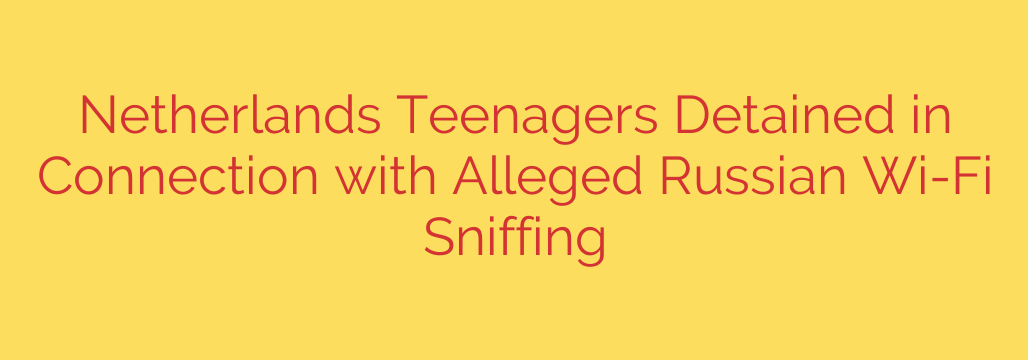
Teen Hackers and Wi-Fi Sniffing: Is Your Data at Risk from Pocket-Sized Hacking Tools?
A startling incident in the Netherlands has cast a harsh spotlight on the growing threat of accessible hacking technology. Dutch authorities recently detained two teenagers, aged 15 and 17, in connection with a sophisticated data-sniffing operation. The case is a stark reminder that powerful cyber-espionage tools are no longer confined to state-sponsored agencies; they can now fit in the palm of your hand.
The investigation centers around the alleged use of a device known as the Flipper Zero to intercept Wi-Fi data from vehicles, including some believed to be connected to the Russian embassy in The Hague. This incident moves beyond a simple case of teenage mischief, touching on serious concerns of national security and diplomatic espionage.
The Tool Behind the Threat: What is a Flipper Zero?
At the heart of this case is the Flipper Zero, a compact, versatile device often described as a “multi-tool for geeks.” While not inherently malicious, its capabilities are extensive and can be easily exploited for illegal activities. The Flipper Zero can interact with a wide range of wireless protocols, including:
- RFID (used in access cards)
- NFC (used in credit cards and mobile payments)
- Infrared signals (like TV remotes)
- Sub-GHz radio signals (used in garage door openers and remote key fobs)
Most critically, with certain firmware, it can be used for Wi-Fi sniffing and penetration testing. This capability allows a user to monitor and capture data packets being transmitted over a wireless network.
Understanding the Danger of Wi-Fi Sniffing
Wi-Fi sniffing, also known as packet sniffing, is the act of intercepting data as it travels over a wireless network. Imagine someone eavesdropping on every conversation happening in a room—that’s essentially what a hacker does to a Wi-Fi network.
If a network is unsecured or poorly secured, a malicious actor can potentially capture a treasure trove of sensitive information, including:
- Usernames and passwords for websites that don’t use proper encryption.
- Private messages sent over unencrypted apps.
- Web browsing history, revealing personal interests and activities.
- Confidential business documents being transferred over a corporate network.
The Dutch case highlights a scenario where this technique could be used to gather intelligence from diplomatic targets. However, the same methods can be used against anyone, from a café patron using public Wi-Fi to an employee on their company network.
How to Protect Yourself from Data Interception
This incident serves as a critical wake-up call for everyone. The democratization of powerful hacking tools means we must be more vigilant about our digital security. Here are actionable steps you can take to protect your data from being sniffed.
1. Ensure Your Home Network Uses Strong Encryption
Check your Wi-Fi router’s security settings. The current standard for security is WPA3 encryption, which is significantly more difficult to crack than its predecessors, WPA2 and WEP. If your router is old and doesn’t support WPA3, consider upgrading.
2. Use a Virtual Private Network (VPN)
A VPN is one of the most effective tools for protecting your data. It creates an encrypted tunnel between your device and the internet, making your traffic unreadable to anyone trying to intercept it. A VPN is essential when using any public or untrusted Wi-Fi network, such as those in coffee shops, airports, or hotels.
3. Be Wary of Public Wi-Fi
Unsecured public Wi-Fi networks are a prime target for hackers. They are notoriously easy to monitor. If you must use one, avoid logging into sensitive accounts like banking or email unless you are using a VPN. If possible, use your phone’s cellular data hotspot instead, as it is generally more secure.
4. Always Look for HTTPS
Before entering any personal information on a website, check the address bar. Ensure the URL begins with “https://” and displays a padlock icon. HTTPS encrypts the data exchanged between your browser and the website, protecting it from eavesdroppers. Modern browsers will often warn you if a site is not secure.
5. Keep Your Devices and Software Updated
Manufacturers and software developers regularly release updates that patch critical security vulnerabilities. Enable automatic updates on your computers, smartphones, and routers to ensure you are always protected against the latest known threats.
The era of pocket-sized cyber threats is here. While law enforcement works to address incidents of misuse, the ultimate responsibility for protecting personal and professional data lies with each of us. By adopting stronger security habits, you can significantly reduce your risk of becoming a victim of data sniffing and other digital threats.
Source: https://go.theregister.com/feed/www.theregister.com/2025/09/29/infosec_in_brief/








